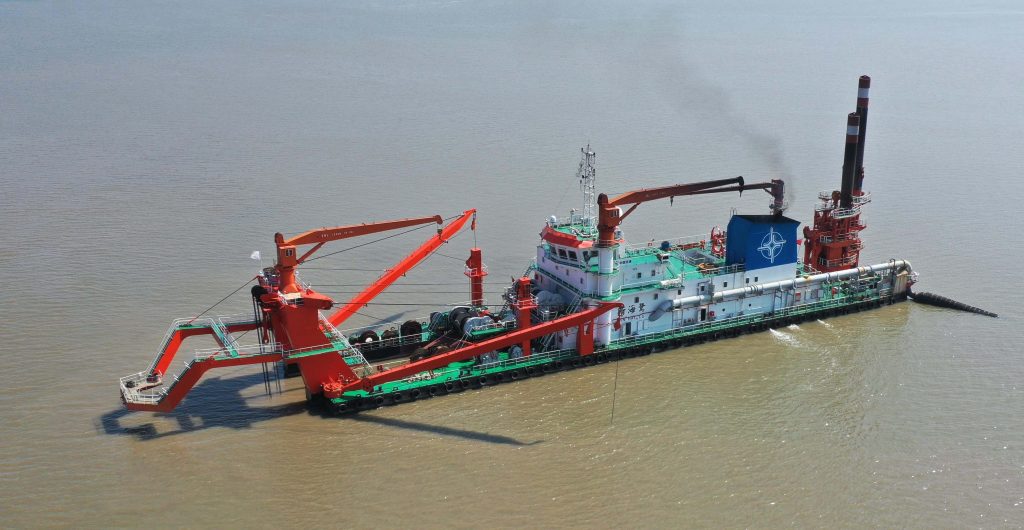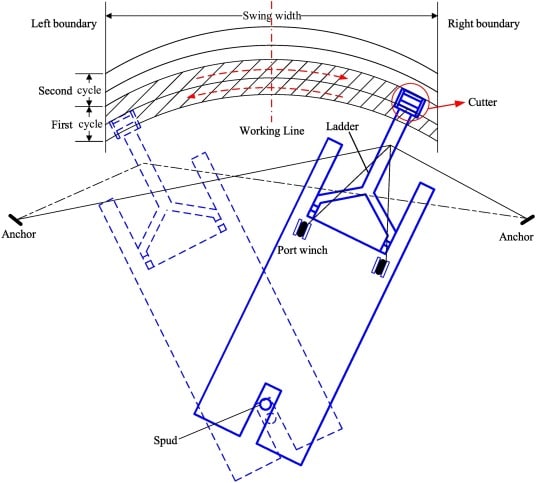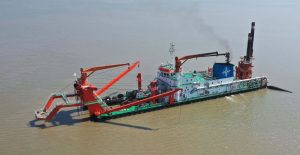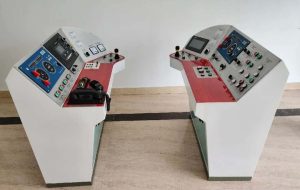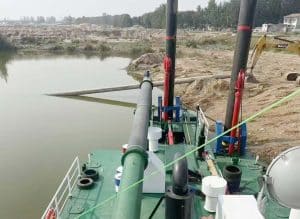🔧 Quick Reference: Anchor Boom Specifications
| Specification | Range |
|---|---|
| Hoisting Force | 3-40 tons |
| Operating Length | 9-30 meters |
| Hauling Speed | 16-30 m/min |
| Dredging Depth | 16-27.5 meters |
Ever wonder how massive dredging ships stay perfectly positioned while digging underwater? The secret lies in a crucial component called the cutter suction dredger anchor boom.
This comprehensive guide reveals everything you need to know about anchor booms. You’ll discover how they work, their specifications, and why they’re essential for modern dredging operations.
What is a Cutter Suction Dredger Anchor Boom?
A cutter suction dredger anchor boom is a mechanical arm that extends from the side of a dredging vessel. Think of it as a giant fishing rod that handles heavy anchor chains instead of fish.
The system includes three main parts:
- The boom arm: Steel structure that extends from the dredger
- Hydraulic or mechanical winches: Provide lifting power
- Control systems: Allow operators to manage positioning
When a cutter suction dredger operates, it needs precise positioning. The anchor boom makes this happen by controlling side anchors without requiring separate work boats.
Figure 1: Main components of a cutter suction dredger anchor boom system
Key Functions and Benefits of Anchor Booms
Anchor booms solve several critical problems in dredging operations. Here’s why they matter:
Repositioning Side Anchors Without Work Boats
Traditional dredging required separate boats to move anchors. This process was slow and expensive. Modern anchor booms eliminate this need entirely.
The boom extends up to 30 meters, allowing operators to place anchors precisely where needed. This saves both time and money on every project.
Keeping Anchor Wires Clear of Cutter Areas
Here’s a major safety benefit: anchor booms prevent anchor cables from getting tangled with the cutter head. When cables enter the cutting zone, they can cause:
- Expensive equipment damage
- Dangerous operational hazards
- Project delays lasting days or weeks
The boom keeps these wires at a safe distance, ensuring smooth operations.
Improving Operational Safety and Efficiency
Studies from marine engineering research show that anchor booms reduce repositioning time by up to 60%. This translates to significant cost savings on large projects.
“Anchor booms have revolutionized our dredging efficiency. We can now complete harbor projects 40% faster than before.” – Senior Dredging Engineer, Port Authority
Figure 2: Anchor boom system operating during a typical harbor dredging project
Types and Technical Specifications
Not all anchor booms are created equal. Let’s break down the main types and their specifications.
Hydraulic vs. Mechanical Systems
Hydraulic anchor booms dominate modern dredging because they offer:
- Precise control through remote operation
- Smooth, consistent movement
- Higher lifting capacities
- Better integration with dredger pump systems
Mechanical systems still exist but are mostly found on older or smaller dredgers.
Capacity Ranges and Real-World Examples
Here’s what you’ll find in today’s market:
Small to Medium Dredgers (CSD650 Model)
- Anchor boom capacity: 12 tons
- Hauling speed: 30 m/min
- Maximum dredging depth: 18 meters
- Cutter power: 700 kW
Large Dredgers (800mm/32″ Model)
- Anchor boom capacity: 60 tons
- Hauling speed: 16 m/min
- Maximum dredging depth: 27.5 meters
- Cutter power: 1,100 kW
Custom Sizing Options
Most manufacturers offer custom configurations. This flexibility matters because dredging projects vary dramatically in scope and requirements.
Custom options typically include:
- Extended boom lengths for deeper operations
- Higher capacity winches for heavy-duty work
- Specialized materials for corrosive environments
- Integrated automation systems
Figure 3: Comparison of anchor boom specifications across different dredger models
Design and Engineering Considerations
Building a reliable anchor boom requires careful engineering. Let’s explore the key design factors.
Material Specifications
Modern anchor booms use high-grade materials to withstand harsh marine conditions:
- Q235 carbon steel for the main frame structure
- Forged steel components for pins and rotating shafts
- High-tensile anchor ropes (1670 MPa strength rating)
- Corrosion-resistant coatings for extended lifespan
Finite Element Method (FEM) Analysis
Engineers use advanced computer modeling to test anchor boom strength before manufacturing. This process, called Finite Element Method analysis, simulates real-world stresses.
The FEM analysis examines:
- Maximum load tolerances
- Connection point stress concentrations
- Material fatigue over time
- Safety factor calculations
Load Calculations and Safety Factors
Safety comes first in anchor boom design. Engineers calculate maximum operational loads, then add substantial safety margins.
For example, if a winch can handle 196.1 kN (about 20 tons), the boom structure is designed to handle at least 300% of this load. This prevents catastrophic failures during unexpected conditions.
Environmental Factor Considerations
Coastal and offshore environments present unique challenges:
- Salt water corrosion requires special protective coatings
- Wave action creates cyclical stress on boom components
- Temperature variations affect material expansion and contraction
- Marine growth can interfere with moving parts
Figure 4: Finite Element Method stress analysis showing load distribution across anchor boom structure
Applications in Different Dredging Operations
Anchor booms excel in various dredging scenarios. Here’s where they make the biggest impact.
Harbor Maintenance and Port Development
Ports worldwide rely on regular dredging to maintain shipping channels. Anchor booms enable precise positioning in confined harbor spaces where traditional anchoring methods fail.
Recent projects like the Lagos-Calabar coastal development demonstrate how anchor booms support large-scale infrastructure projects.
Deep-Water Dredging Projects
When dredging depths exceed 20 meters, anchor booms become essential. They provide the extended reach needed to position anchors in deep water while maintaining precise dredger positioning.
Offshore Construction
Offshore wind farms and oil platforms require precise seabed preparation. Anchor booms allow dredgers to work accurately in challenging offshore conditions.
Mining Operations
Sand and gravel extraction operations benefit from anchor boom stability. The sand pump systems work more efficiently when the dredger maintains steady positioning.
Figure 5: Anchor boom applications across different dredging environments and project types
Safety Features and Maintenance Requirements
Proper maintenance keeps anchor booms operating safely for decades. Here’s what you need to know.
Regular Inspection Protocols
Daily inspections should cover:
- Visual checks for cracks or deformation
- Wire rope condition including fraying or corrosion
- Hydraulic fluid levels and leak detection
- Pin and bearing lubrication status
Weekly inspections go deeper:
- Torque verification on critical bolts
- Hydraulic pressure testing
- Electrical system diagnostics
- Emergency stop system verification
Common Wear and Corrosion Issues
Marine environments are tough on equipment. Watch for these common problems:
⚠️ Critical Wear Points
- Pin connections: Check for elongation or wear
- Wire rope attachment points: Look for fraying or fatigue
- Hydraulic seals: Monitor for leaks or degradation
- Boom pivot points: Ensure smooth operation
Troubleshooting Guide
When problems arise, systematic troubleshooting saves time and money:
Problem: Slow boom movement
Solution: Check hydraulic fluid viscosity and filter condition
Problem: Excessive noise during operation
Solutions: Inspect bearings and lubrication points
Problem: Erratic boom positioning
Solution: Calibrate control system and check sensor alignment
Compliance with International Standards
Modern anchor booms must meet strict international standards:
- ISO 9001 quality management systems
- IMO regulations for marine equipment
- Local maritime authority requirements
- Environmental protection standards
Figure 6: Regular maintenance procedures ensure anchor boom reliability and safety
Cost Factors and Pricing Considerations
Understanding anchor boom costs helps with project planning and budgeting.
Initial Investment Costs
Anchor boom prices vary significantly based on specifications:
- Small systems (3-12 tons): $150,000 – $300,000
- Medium systems (15-30 tons): $300,000 – $600,000
- Large systems (40+ tons): $600,000 – $1,200,000
Custom features add 20-40% to base prices, but often justify themselves through improved efficiency.
Installation and Setup Expenses
Don’t forget these additional costs:
- Shipyard installation fees (10-15% of equipment cost)
- System integration and testing (5-8% of equipment cost)
- Crew training and certification ($10,000 – $25,000)
- Spare parts inventory (5-10% of equipment cost)
Maintenance and Operational Costs
Annual operating costs typically include:
- Routine maintenance: 2-4% of initial investment
- Hydraulic fluid replacement: $2,000 – $5,000 annually
- Wire rope replacement: $5,000 – $15,000 every 2-3 years
- Major overhauls: 8-12% of initial cost every 10-15 years
ROI Considerations
Quality anchor booms typically pay for themselves within 3-5 years through:
- Reduced work boat rental costs
- Faster project completion times
- Lower equipment damage rates
- Improved operational safety
Case Studies and Industry Examples
Real-world examples demonstrate anchor boom effectiveness across different projects.
Successful Projects in Developing Markets
🌍 Case Study: Southeast Asian Port Expansion
Project: 2.5 million cubic meter harbor deepening
Dredger: 650mm CSD with 12-ton anchor boom
Results: Completed 25% ahead of schedule, saving $2.1 million in costs
Key Success Factor: Anchor boom eliminated need for three work boats, reducing daily operational costs by $8,000.
🌍 Case Study: African Coastal Infrastructure
Project: New port construction in challenging surf conditions
Dredger: 800mm CSD with 60-ton anchor boom system
Results: Maintained 95% uptime despite difficult weather conditions
Key Success Factor: Heavy-duty anchor boom provided stability in 3-meter wave conditions.
Performance Data and Results
Industry data shows consistent benefits across projects:
- Positioning accuracy improved by 40-60% compared to traditional methods
- Operational uptime increased by 15-25% due to reduced anchor-related delays
- Safety incidents decreased by 70% in anchor handling operations
- Project completion times reduced by 20-35% on average
Customer Testimonials and Reviews
“The anchor boom system transformed our operations. We’ve completed three major projects without a single anchor-related incident. The investment paid for itself in just 18 months.” – Project Manager, International Dredging Contractor
Figure 7: Anchor boom system successfully operating in challenging offshore conditions
Future Trends and Technology Innovations
The anchor boom industry continues evolving with new technologies and market demands.
Automated Control Systems
Next-generation anchor booms feature:
- GPS-guided positioning for centimeter-level accuracy
- Automated anchor deployment reducing crew workload
- Real-time load monitoring preventing equipment overload
- Remote operation capabilities improving safety
These systems integrate with modern cutter suction dredger control systems for seamless operation.
Advanced Materials and Durability Improvements
Material science advances are delivering:
- Composite materials reducing weight while maintaining strength
- Advanced coatings extending component lifespan by 50-70%
- Smart materials providing self-diagnostic capabilities
- Eco-friendly lubricants meeting environmental regulations
Market Growth Projections
Industry analysts predict strong growth driven by:
- Infrastructure development in emerging economies
- Climate change adaptation requiring coastal protection
- Renewable energy projects creating offshore opportunities
- Port automation trends demanding more sophisticated equipment
The global dredging equipment market is expected to grow 4-6% annually through 2030, with anchor boom technology leading innovation.
Emerging Applications
New opportunities include:
- Underwater mining operations requiring precise positioning
- Environmental remediation projects in sensitive areas
- Aquaculture support for offshore fish farming
- Disaster response for emergency channel clearing
FAQ Section
❓ Frequently Asked Questions
Q1: What is the purpose of an anchor boom on a cutter suction dredger?
A1: Anchor booms reposition side anchors without work boat assistance. They keep anchor hoisting wires away from the cutter head, preventing wire damage during dredging operations.
Q2: How strong are anchor booms typically?
A2: Anchor booms range from 3 tons at 9 meters length up to 40 tons at 30 meters. Exact strength depends on dredger size and operational requirements.
Q3: Are hydraulic anchor booms common?
A3: Yes, hydraulic anchor booms provide efficient, controlled anchor movement. They integrate with hydraulic winches and remote controls for precise operation.
Q4: How do anchor booms improve dredging safety and efficiency?
A4: By keeping anchor wires clear of cutter areas, anchor booms prevent cable damage and reduce downtime. They enable quicker anchor repositioning, enhancing operational efficiency and safety.
Q5: What are typical dredging depths for cutter suction dredgers equipped with anchor booms?
A5: Dredging depths vary from 16 meters for smaller CSDs to over 27 meters for larger vessels equipped with anchor booms and spud carrier systems.
Q6: Can anchor booms be customized?
A6: Yes, manufacturers offer standard ranges but provide custom sizes and configurations to fit specific dredging project requirements.
Conclusion
Cutter suction dredger anchor booms have revolutionized modern dredging operations. From 3-ton systems for small harbors to 40-ton giants for offshore projects, these mechanisms deliver safety, efficiency, and cost savings.
The key benefits are clear:
- Eliminate expensive work boat requirements
- Prevent costly equipment damage
- Improve project completion times by 20-35%
- Enhance operational safety significantly
As dredging projects become more complex and demanding, anchor booms will continue evolving. Advanced materials, automated controls, and smart monitoring systems represent the future of this critical technology.
Whether you’re planning a harbor expansion, coastal protection project, or offshore development, understanding anchor boom capabilities helps ensure project success.
🚢 Ready to Upgrade Your Dredging Operations?
Ocean Blue Company has over 25 years of experience manufacturing high-quality anchor boom systems for cutter suction dredgers worldwide.
✓ Custom solutions for your specific needs
✓ Complete turnkey services from design to maintenance
✓ Proven track record in 50+ countries
Contact our experts today for a free consultation and discover how our anchor boom systems can transform your dredging efficiency.

